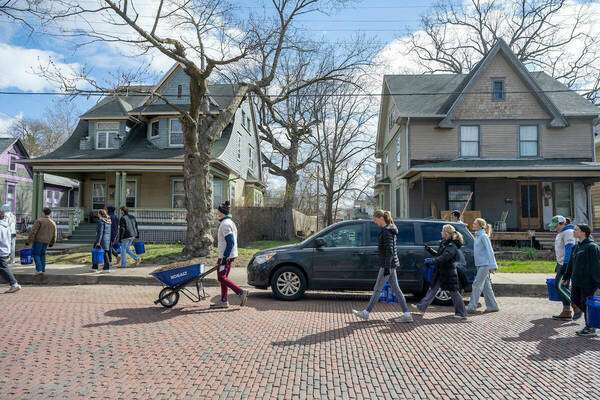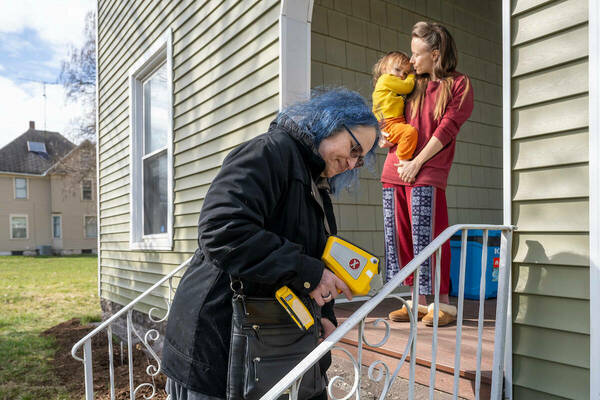South Bend is vulnerable to lead poisoning — here’s how ND-LIT can help
Heidi Beidinger is passionate about science and public health which has fueled her nearly 10-year crusade to get children tested for lead poisoning and help their families remediate lead found in and around their homes. The source of the poisoning is often lead-based paint, used widely in U.S. homes built before 1978 when the government banned its use.
“We absolutely need to get kiddos tested and we are doing an abysmal job of it in the U.S. In Indiana, not even 20 percent of children are tested,” Beidinger said.
The public health and policy expert is an associate professor in the Eck Institute for Global Health at the University of Notre Dame and a founding member of the Notre Dame Lead Innovation Team. Since its inception in 2016, ND-LIT has partnered with organizations — including the St. Joseph County Department of Health and the city of South Bend — to help local families live “lead safe.”
How lead poisoning happens
Children are exposed to lead by inhaling lead dust or ingesting dust that’s on their hands or toys. Lead dust settles on the floors and surfaces of homes. It accumulates at the base of window sills and doorways from the friction of opening and closing windows and doors. Lead dust also seeps into the soil around a home painted with lead-based paint and shoes track the dust into the home.
“Lead poisoning is devastating to childhood development. We are particularly concerned about kids that are under seven because of the rapid development that happens at that age. Their metabolism is twice as fast as adults. They breathe at twice the rate of adults. So they are absorbing lead much more quickly than adults do,” Beidinger said.
The effects of lead poisoning mimic symptoms of attention deficit hyperactivity disorder, which can mean some children are unnecessarily medicated for ADHD, while their exposure to lead — and the cognitive damage — continues.
South Bend is vulnerable
Lead exposure is suspected to be a significant issue for South Bend since 80 percent of the city’s homes were built before 1978. State data from 2016 revealed parts of South Bend had some of Indiana’s highest rates of children with elevated levels of lead in their blood.
At the time of the data's release, Beidinger was a member of the St. Joseph County Board of Health and a new faculty member at Notre Dame. She consulted with University faculty to see how multiple disciplines of study could come together to help South Bend.
ND-LIT is formed

That same year, the ND-LIT team was founded. The team conducts research on new and innovative technologies related to lead and environmental health and justice. It also developed an easy-to-use and highly accurate home lead screening kit available to the public at no cost on its website and during its annual Mulch Madness event.
Mulching is an important strategy for limiting exposure to lead that may exist in the soil found around a home’s foundation, gardens and/or play areas.
“Mulch Madness has become an important annual event to our team’s mission to prevent lead poisoning. Our students work together with community members and organizations and the city of South Bend to provide education, lead screening kits and mulch to neighborhoods at higher risk for lead exposure,” Beidinger said. The St. Joseph County Health Department is also on site during the event to provide lead testing for children.
Mulch Madness
Beidinger and chemistry professor Marya Lieberman, another of ND-LIT’s founders, were in the Near Northwest Neighborhood on March 23 for this year’s Mulch Madness. Lieberman, a chemistry professor, brought with her a handheld instrument to scan soil and painted surfaces for lead — it offers immediate readings.
While students mulched the yards of appreciative homeowners, Lieberman offered to scan soil samples for homeowners interested in knowing whether lead is present in their soil and at what levels. ND-LIT uses the Environmental Protection Agency’s lead safety scale.
Of the soil samples collected from 19 homes in the neighborhood, ND-LIT found 17 homes had at least one soil sample that was above the level the EPA considers safe for play areas and gardens. One soil sample surpassed the level at which the EPA recommends soil be dug up and sent to a landfill. Homeowners will be notified of the findings.
Knowledge is power

Neighborhood resident Sally Geislar, mother of a 2-year-old and pregnant with her second child, eagerly gave Lieberman permission to scan her house and yard. Lieberman found lead present in the soil, on a painted iron railing on the porch and on painted wood trim inside the home.
“While the lead is not going to leap off the wall and hurt the child, it is really important to know it’s there and take steps to minimize exposure,” Lieberman said.
She offered Geislar practical advice on how to safely manage lead hotspots.
“There were some spots on the wood trim where the paint was chipping and flaking and so I suggested she use wet scraping, a technique where you get a squirt bottle with water and you scrape the wet area with a paint scraper. The water keeps (lead) dust from forming. If you do sanding or dry scraping, you get (lead) dust all over the house and wet scraping minimizes that,” Leiberman said.
Geislar was appreciative to receive not only the readings, but advice on how to keep her home and her family ‘lead safe.’
“I received some clear steps to take — very practical things to do,” she said.
Where to start
ND-LIT urges parents and guardians to have their children tested for lead. You can do so at the St. Joseph County Health Department or ask your health provider.
If children test positive, the families are encouraged to check whether there is lead in their homes. You can screen your home with a free kit, or ask the health department for a more extensive screening.
The next step would be lead remediation. The City of South Bend has a large lead remediation fund through the US Department of Housing and Urban Development. Families are encouraged to apply for up to $20,000 for lead remediation work on their homes, depending on their income.
Living ‘lead safe’
If you suspect there’s lead in your home, here are some things you can do:
-
Cover the soil around your home with mulch, pea gravel or bushes
-
Cover windows with clear plastic from the inside
-
Take off your shoes before coming into the house
-
Wash your hands — and make sure your kids do the same — before eating
-
Eat nutritious foods
“When you have a healthy diet and you have a full belly, the body can expel the lead on its own. If you have a belly full of non-nutritious food, the lead hangs out and the body doesn’t expel it as quickly,” Beidinger said.
The City of South Bend also has extensive “Take Action at Home” tips on its website.
Originally published by at publicaffairs.nd.edu on March 27, 2024.
Latest Research
- Senator Todd Young and NSF Director Sethuraman Panchanathan visit Notre Dame to discuss critical investments in science and technologyOn Thursday, April 25, Sethuraman Panchanathan, director of U.S. National Science Foundation (NSF), joined U.S. Senator Todd Young in a visit to the campus of the University of Notre Dame. The pair met with faculty, students, and University leaders and discussed how research and innovation can drive…
- White House’s Jake Braun addresses statewide cybersecurity summit at Notre DameOn April 18, 2024, leaders in cybersecurity from government, industry, and academia gathered for the 2024 Indiana Statewide Cybersecurity Summit hosted by the University of Notre Dame in collaboration with co-sponsors Indiana University, Purdue University,…
- Hauenstein, Putman named as Simons FellowsTwo University of Notre Dame professors were named fellows of the Simons Foundation for 2024, which will allow them the opportunity to intensely focus on their research for up to a year. Jonathan…
- Literacy scholar Ernest Morrell elected to American Academy of Arts & SciencesErnest Morrell, the Coyle Professor of Literacy Education at the University of Notre Dame, has been elected to the American Academy of Arts and Sciences, one of the nation’s oldest learned societies and independent policy research centers. Morrell was one of the 250 members of the newest AAAS class announced today. Other notable names among the group include filmmaker George Clooney, Apple CEO Tim Cook, novelist Jhumpa Lahiri, and Pulitzer Prize-winning New York Times columnist and 1993 Notre Dame alumnus Carlos Lozada.
- Notre Dame faculty fight malaria resurgence in BangladeshBetween 2008 and 2020, districts across the country of Bangladesh saw a 93% reduction in malaria cases. Today, as the world reflects on the World…
- Anthropologist's research shows there’s no ‘one size fits all’ when it comes to addressing men’s health issues globallyAt a time when health resources are at a premium and need to be wisely allocated, health professionals must find points within men’s lives when it makes the most sense to intervene and advocate for preventive care for promoting better health outcomes. Life transitions such as marriage and fatherhood are often pivotal and crucial intervention points. But just like every man is different, health concerns across global communities differ as well. Research from the University of Notre Dame finds that not all life transitions produce the same health results, and not all men’s global health policies should look the same from one country to another.













